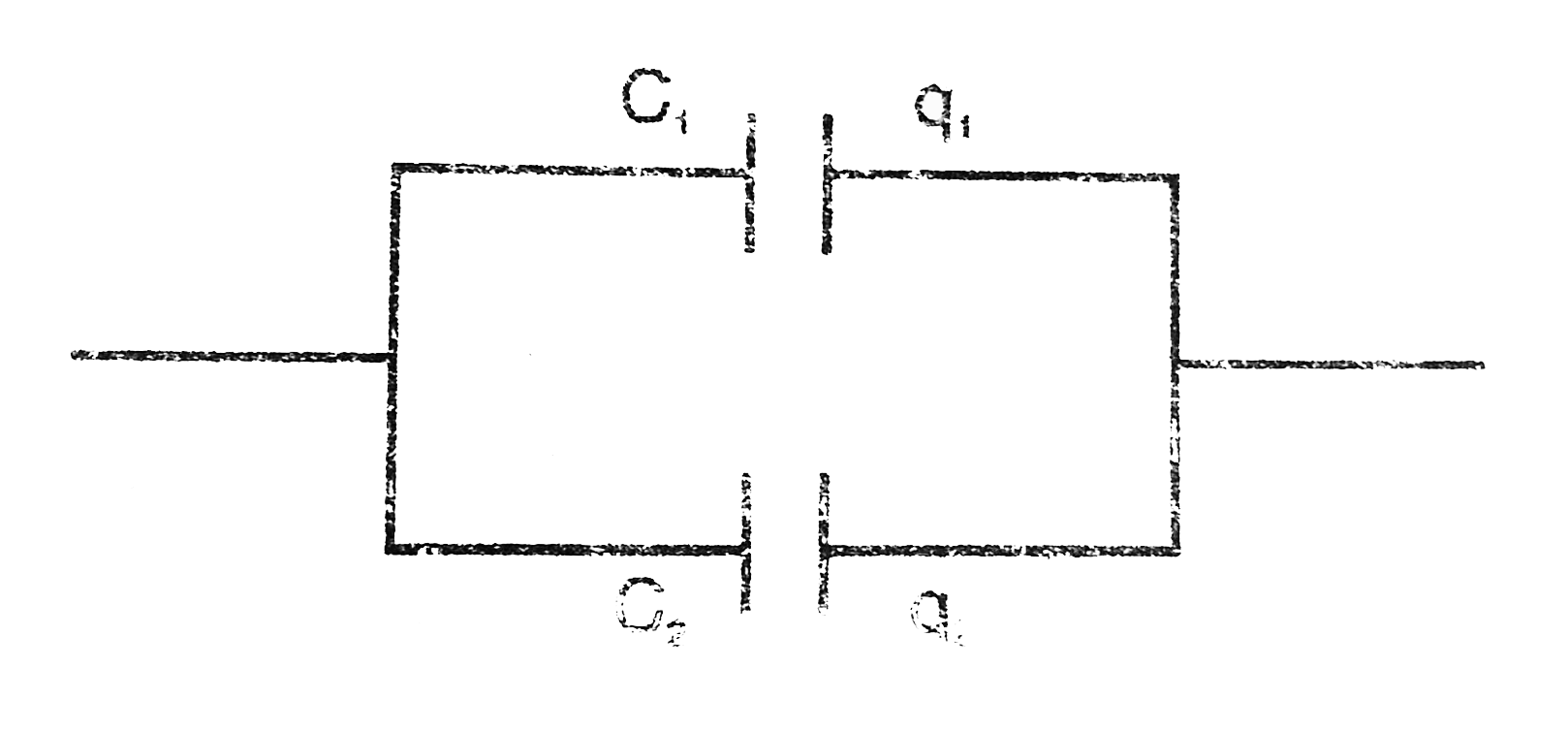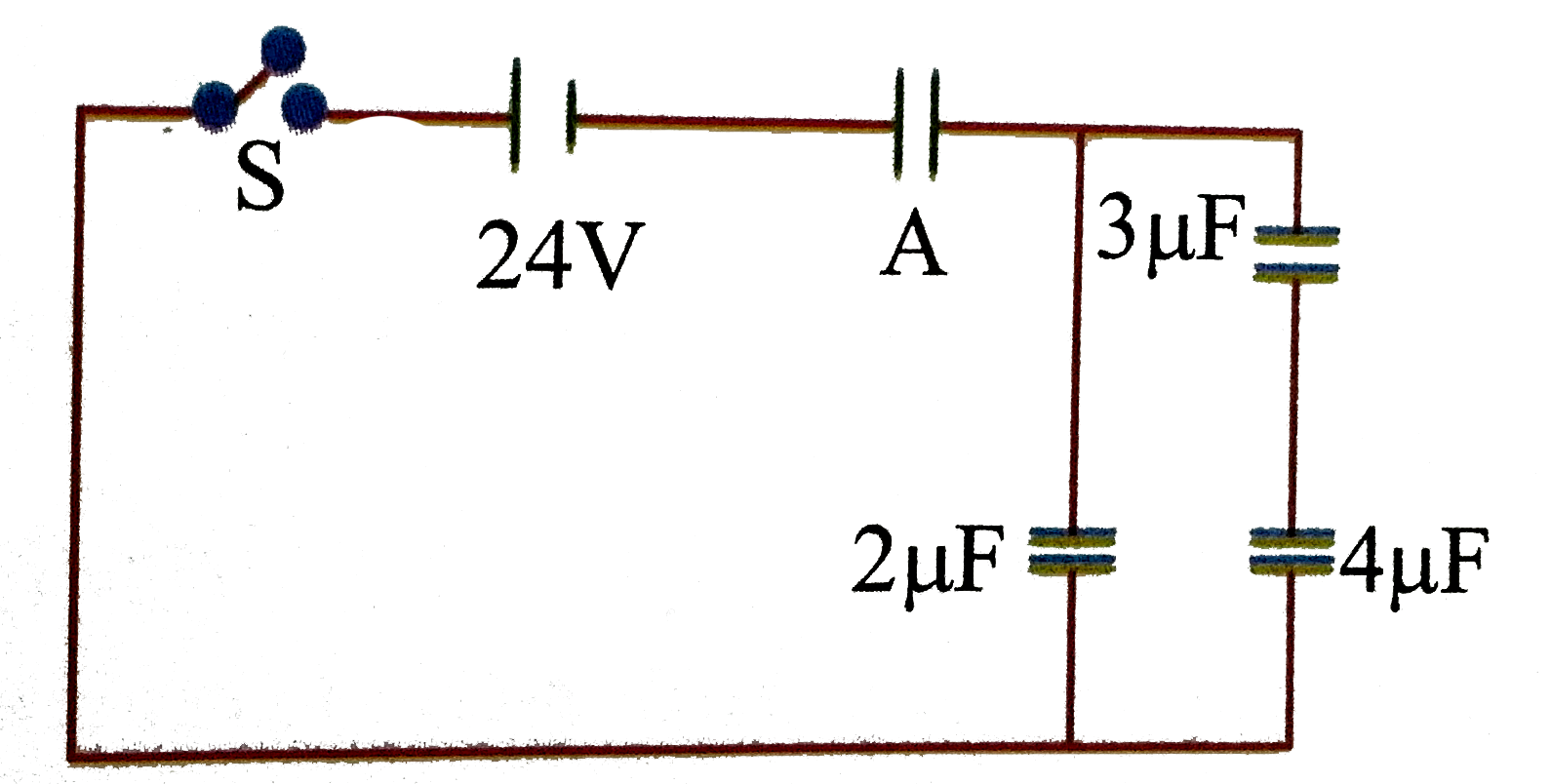A 100μF capacitor is charged to a potential difference of 24V. It is connected to an uncharged capacitor of capacitance 20μF What will be the new potential difference across the 100μF capacitor? Solution in Tamil
C1=100pF,V=25V
Uncharged capacitor of capacitance
C2=20pF
Total charge q=C1V=24×100pF
When the charge capacitor is connected with the uncharged capacitor
q1+q2=24×100qFandq_1 / C_1 = q_1 / C_1<br>q1100=q120
or q_1 = 5 q_2<br>Fromequation(i)and(ii),wehave<br> q_1 = 20 xx 100pF<br>v_1 = q_1 / C_1 <br>= 20 xx 100 pF / 20 pF = 20 V

Topper's Solved these Questions
Similar Questions
The capacitance of a capacitor does not depend on
05:58View SolutionThe bohr radius is given by a0=ε0h2πme2 verify that the RHS has dimesions of length
04:00View SolutionA flint glass prism and a crown glass prism are to be combined in such a way that the deviation of the mean ray is zero. The refractive index of flint and crown glasses for the mean ray are 1.620 and 1.518 respectively. If the refracting angle of the flint prism is 6.0∘, what would be the refracting angle of the crown prism ?
03:02View SolutionA100μF capacitor is charged o a potential difference of24V. It is connected to an uncharged capacitor of capaciance20μFWhat will be the new polential diffeernce across the 100 pF capacitor?
05:38View SolutionA capacitor of capacitance 10μF is charged to a potential 50V with a battery. The battery is now disconnected and an additional charge 200μC is given to the positive plate of the capacitor. The potential difference across the capacitor will be.
04:43View SolutionFour capacitor and a battery of emf24V are connected as shown in the figure. Initially, S is open and the capacitors are uncharged. After S is closed and steady state is attained, the potential difference across the 4μf capacitor is 7.5V. The capacitance in μf of the capacitor A is.
 .02:39View Solution
.02:39View Solution10μF की धारिता वाले संधारित्र को 100 V के विभवांतर पर आवेशित किया जाता है। यदि एक अनावेशित संधारित्र को इसके समान्तर में जोड़ा जाए तो उभयनिष्ठ विभवांतर (common potential difference) 40 V होता है। दूसरे संधारित्र की धारिता (capacity) निकालें।
02:43View SolutionTwo capacitors of capacitances 0.5 mu F and 0.75 mu F are connected in parallel. A potential difference of 600 V is applied to this combination. What are the charges on the two capacitors? Now, the two capacitors are connected in series and the same potential difference is applied. Find out the charges on the capacitors in this case.
03:41View SolutionThe capacitances of two capacitors are 2μF and 8μF. They are connected in series and a potential difference of 100 V is applied across the combination. What are
The total charge of the combination04:34View SolutionThe capacitances of two capacitors are 2μF and 8μF. They are connected in series and a potential difference of 100 V is applied across the combination. What are
Charges on both the capacitors, and03:25View SolutionThe capacitances of two capacitors are 2μF and 8μF. They are connected in series and a potential difference of 100 V is applied across the combination. What are
The potential differences across the two capacitors?03:55View SolutionA capacitor of capacitance 2 mu F is charged with 20 V potential. Another uncharged capacitor of capacitance 3 mu F is connected parallely with the first capacitor. What will be the potential difference at the two ends of the combination? Calculate the amounts of charge of the capacitors.
02:29View SolutionA 10μF capacitor is charged by a 30 V dc supply and then connected across an uncharged 50μF capacitor. Calculate
The final potential difference across the combination.03:09View SolutionA capacitor of 30μ F charged to 100Vis connected in parallel to capacitor of 20μ F charged to 50V .The common potential is ...?
03:41View SolutionTwo capacitors 2 μF and 4 μF are connected in series and a potential of 100 V is applied across the combination. Energy stored in the capacitors is
04:25View Solution[" Chemistry "],[" The potential difference across a "2 mu F" capacitor is "18V],[" when it is not connected to anything.It is then connected in "],[" parallel with an uncharged "4 mu F" capacitor.In equilibrium the "],[" charge "q" on the "2 mu F" capacitor and the potential difference "],[V/" across it,then "]
View Solution

